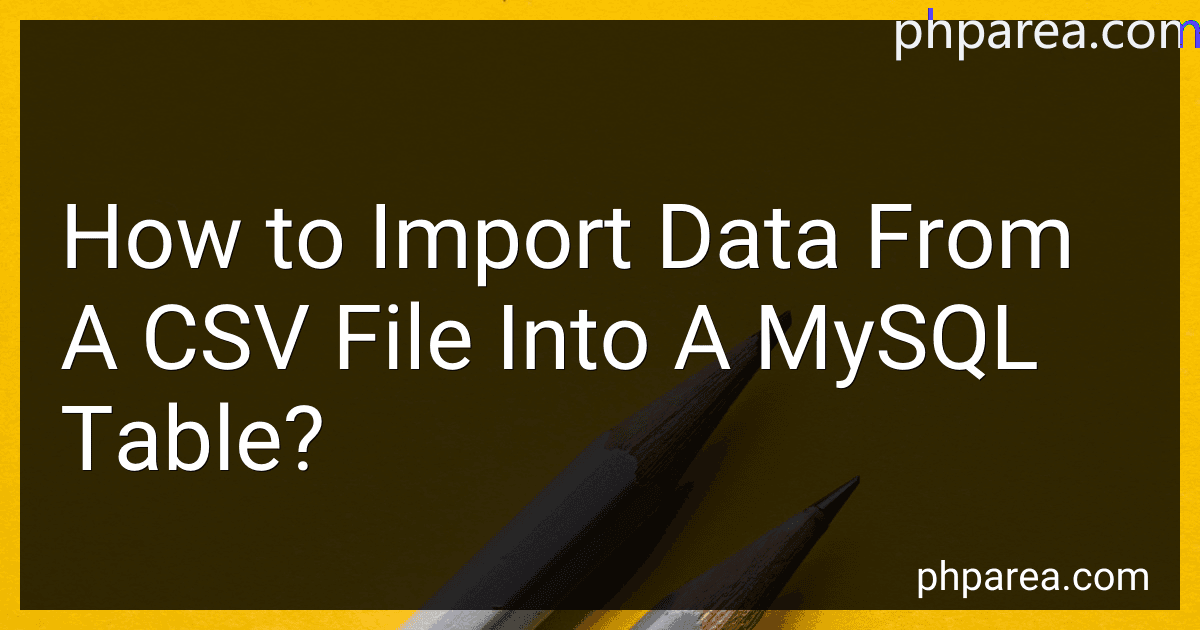Best Tools to Import CSV to MySQL to Buy in December 2025

CSB Men's Daily Bible, Brown Genuine Leather, Black Letter, Reading Plan, Articles, Callouts, Study Tools, Easy-to-Read Bible Serif Type



CSB Men's Daily Bible, Brown Genuine Leather, Indexed, Black Letter, Reading Plan, Articles, Callouts, Study Tools, Easy-to-Read Bible Serif Type



THE BEST 160 PRACTICE QUESTIONS PANDAS - PYTHON!!: Includes topics such as Data frames, Series, Export-Import between Pandas and SQL, SQLite, Excel, CSV ... comparison and real cases (Spanish Edition)


To import data from a CSV file into a MySQL table, you can use the LOAD DATA INFILE statement. This statement allows you to import data from an external file into a specified table.
Here's the basic syntax for importing data from a CSV file:
LOAD DATA INFILE 'filename.csv' INTO TABLE table_name FIELDS TERMINATED BY ',' ENCLOSED BY '"' LINES TERMINATED BY '\n' IGNORE 1 ROWS;
Let's break down the components of this syntax:
- LOAD DATA INFILE: This statement is used to load data from a file.
- 'filename.csv': Replace this with the path and name of your CSV file.
- INTO TABLE table_name: Specifies the table in which you want to import the data.
- FIELDS TERMINATED BY ',': Specifies the character that separates fields (columns) in the CSV file. Here, we use a comma (,).
- ENCLOSED BY '"': Specifies the character that encloses fields. Typically, a double quote (") is used.
- LINES TERMINATED BY '\n': Specifies the line terminator character. In this case, it is a new line (\n).
- IGNORE 1 ROWS: This optional clause ignores the first line/header row of the CSV file, assuming it contains column names and not actual data.
Make sure that the table structure matches the data in the CSV file. The number and order of columns should align.
Once you have the LOAD DATA INFILE statement ready with the appropriate information, you can run it in a MySQL client or command-line interface. It will read the CSV file and import the data into the specified MySQL table.
How to handle NULL values in a CSV file during import?
When handling NULL values in a CSV file during import, you can consider the following approaches:
- Skip the row: If the presence of a NULL value in a specific row is problematic for your import process, you can choose to skip that particular row entirely and move on to the next. This approach assumes that the row with the NULL value is not crucial or necessary for your import process.
- Replace with default values: Instead of skipping the row completely, you can replace the NULL values with appropriate default values. This approach ensures that all rows are processed during import, even if they contain NULL values. For example, you can replace a NULL value in a numeric column with zero or a NULL value in a date column with the current date.
- Convert to empty values: If it is acceptable to consider NULL as an empty value in your import process, you can replace NULL values with empty strings or other suitable representations depending on the data type. This approach allows you to retain the row and treat NULL values as empty values.
- Treat NULL as a special value: In some cases, NULL values may carry specific meaning in your dataset. Instead of skipping or replacing them, you can opt to treat them as a distinct value during import and handle them accordingly in your data processing or analysis workflow.
- Modify column data types: If you encounter NULL values in a column that should not allow them, you might need to adjust the column's data type. For instance, if a column is defined as "not null" but contains NULL values, you can modify the data type to allow NULL values.
The choice of how to handle NULL values depends on your specific requirements and the nature of the data being imported. It is essential to identify the most appropriate approach that ensures data integrity and consistency for your use case.
What is the procedure for importing data from multiple CSV files?
The procedure for importing data from multiple CSV files typically involves the following steps:
- Identify the CSV files: Determine the location and names of the CSV files that need to be imported. Make sure you have access to these files.
- Prepare the data: Review the structure and format of the CSV files to ensure they have consistent column headers and data types. If needed, you may need to clean and transform the data to match the requirements of your target system.
- Choose an importing tool or programming language: Select a tool or programming language that can handle CSV file imports. Popular choices include Excel, Python, R, SQL, and other data integration tools.
- Define the import process: Decide how you want to import the data. For example, you may import each CSV file into separate tables or merge them into a single table. Determine the relationships between the CSV files and the target data structure.
- Write the import script: If you are using a programming language like Python or R, write a script that reads the CSV files and performs the import. This script should define the necessary logic, such as looping through all files, reading the data, and inserting it into the target system.
- Execute the import script: Run the import script to initiate the data import process. The script should handle any errors or exceptions that may occur during the import.
- Validate and verify the imported data: After the import process is complete, carefully review and validate the imported data. Check for any discrepancies, missing values, or data integrity issues.
- Perform necessary data transformations or cleanup: If you discover any issues with the imported data, perform the required transformations or cleanup to resolve them. This may involve further scripting or data manipulation.
- Update the imported data: Depending on your use case, you might need to update or synchronize the imported data with your target system periodically. Determine the frequency and schedule for updating the data.
- Document the import process: Keep a record of the import process, including the tools, scripts, and steps taken. This documentation will be useful for future reference or if modifications are needed.
Remember to consider data security and privacy measures during the entire process.
What is the maximum number of rows supported in a MySQL table?
The maximum number of rows supported in a MySQL table depends on the storage engine being used. However, in most practical cases, the limit is very large and typically exceeds the needs of most applications.
For the commonly used InnoDB storage engine, the maximum number of rows is around 232 (4,294,967,296 rows). This is because InnoDB uses a 32-bit row ID, which limits the number of rows that can be stored.
Other storage engines like MyISAM, which is now deprecated in favor of InnoDB, also have similar limits. MyISAM can theoretically support up to 264 (18,446,744,073,709,551,616) rows, but in practice, it may be limited by other factors like available disk space or operating system constraints.
It is worth noting that the maximum number of rows supported also depends on other factors such as the available disk space, the operating system, and the hardware configuration.
